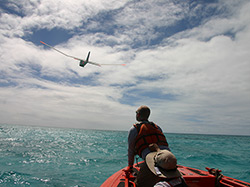Scientists use Unmanned Aircraft Systems to survey wildlife in PMNM
From June 16-23, 2014, scientists conducted research in the Northwestern Hawaiian Islands (NWHI) using a Puma Unmanned Aircraft System (UAS) deployed from NOAA Ship Hiʻialakai. Researchers from NOAA and U.S. Fish & Wildlife Service used the system to perform surveys of monk seals, sea turtles, sea birds and vegetation and to look for marine debris in Papahānaumokuākea Marine National Monument.
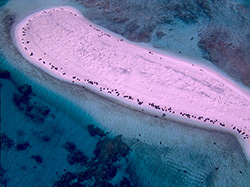
A view of Trig Island from the Puma. Numerous sea turtles and some monk seals can be seen. Credit: NOAA
The UAS made a total of seven flights, one over Trig Island and four over Tern Island, both at French Frigate Shoals, and two at Nihoa. Researchers were excited about the results of the deployments. The operation validated hopes that the UAS could be used to obtain data that couldn’t otherwise be acquired in the Monument without disturbing wildlife.
Researchers were able to survey remote coves for monk seals and sea turtles in conditions that may not have been safe to land people ashore. They were also able to get good imagery of some of the islands at French Frigate shoals and survey for seabirds along the cliffs of Nihoa.
In July, researchers will utilize NASA’s Ikhana UAS, which has a further range and higher resolution optics, to conduct similar activities in both the Main and Northwestern Hawaiian Islands. Scientists will compare data collected from both systems with traditional survey methods and satellite data to assess the best use of this technology for managing the Monument in the future.
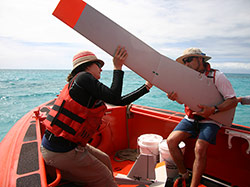
Puma operator ENS Kerryn Schneider (left) and UAS Project Lead Todd Jacobs (right) assemble the Puma for deployment. Credit: Justin Rivera/NOAA
Resource managers are hopeful that this type of technology will be able to supplement monitoring and research efforts in the Monument, as well as other large-scale protected areas.
See more pictures.
Watch the videos.
Read the Press Release.
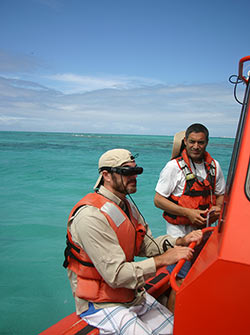
Dr. Charles Littnan views images from the Puma while Project Lead Todd Jacobs looks on. Credit: Justin Rivera/NOAA
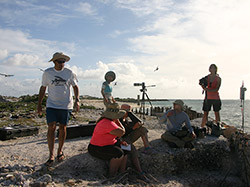
UAS team at Shell Beach on Tern Island. NOAA UAS Project Lead Todd Jacobs (left, standing), USFWS National Wildlife Refuge Biological Science Technician Michele Kuter (seated, in pink), NOAA Puma operators ENS Kerryn Schneider (looking into viewer) and LTJG Tanner Sims (seated, right), with filmmakers Andrew (standing, in background) and Robin Eitelberg (standing, with camera) on hand. Credit: Justin Rivera/NOAA
